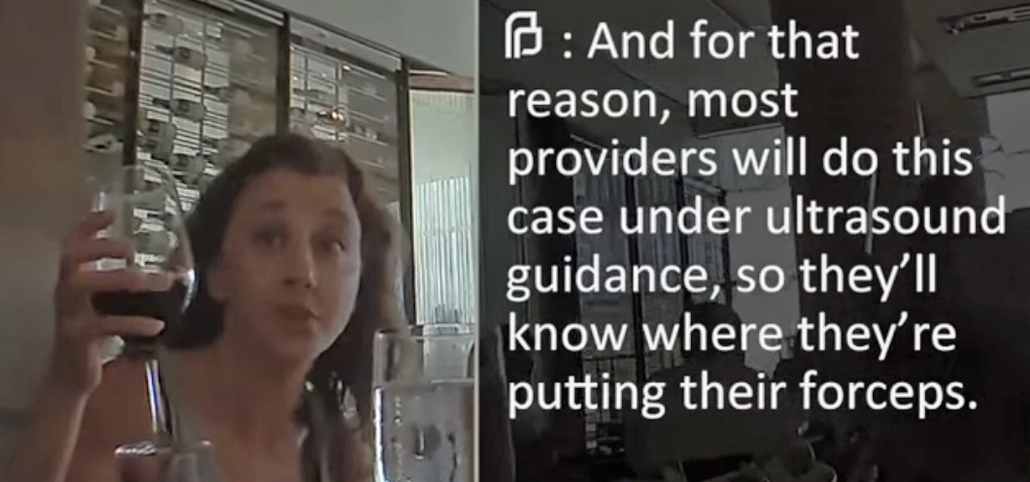one year ago yesterday, a group that almost no one had ever heard of before released an undercover video. The video produced by the Center for Medical Progress (CMP) showed a national-level executive of Planned Parenthood admitting that the abortion provider sells intact fetal body parts.
Over the next few weeks CMP released other videos. The pro-life movement was electrified. Many defenders of life thought to themselves, This changes everything.
Only, it didn’t.
 The videos garnered a surprising amount of media attention, sparked congressional hearings, and launched dozens of investigations into Planned Parenthood (PP). But one year later, not much has changed. And many people are wondering what went wrong.
The videos garnered a surprising amount of media attention, sparked congressional hearings, and launched dozens of investigations into Planned Parenthood (PP). But one year later, not much has changed. And many people are wondering what went wrong.
In what follows I attempt to provide a partial answer to that question. But before I do let me state unequivocally that this is not intended as a criticism of CMP. The scrappy upstart single-handedly took on the abortion behemoth, and while CMP didn’t deliver a knockout blow to PP, it gave them a black eye. CMP deserves our continued praise for such bold efforts.
A post-mortem consideration can be valuable, though, not as an exercise in second-guessing, but as a potential roadmap for what other groups can do in the future. CMP is likely to inspire other activist groups to think of creative ways to bring justice for the unborn. By learning from the past year, they can be better prepared to carry on that task.
Here then are five reasons why the videos didn’t have the lasting effect we were hoping for.
1. Lack of Coordination
The day CMP released their first video several people asked me, “What do you know about this group? Are they reputable?” Like everyone else, I knew almost nothing about them and had to base my impression of CMP’s reputation from clues and inferences. Few of the major pro-life organizations seemed to know about them either. This new group seemed determined to make their mark without outside help.
For 40 years the mainstream pro-life movement has had to be careful about being seen associating with extremists, activist groups who have often done more harm to the cause than good. Many did take a chance in promoting CMP’s videos, but prior coordination could have made the initial launch broader and more effective.
Even after several weeks of releasing videos, CMP did not enlist the efforts of other groups. Most pro-life groups first saw the videos at the same time as the executives at abortion clinics did. Unfortunately, CMP’s actions weren't unusual. Many non-profit and activist groups refuse to coordinate efforts with other groups, mostly out of fear losing constituents.
However, the pro-life movement has succeeded in the past 10 years largely by refusing to take a go-it-alone approach. You’ll often find pro-life groups promoting each other’s campaigns and lending support, especially in the area of communications and strategy. Had CMP tapped into that network, their initial efforts could have reached a larger audience even faster. And when taking on a powerhouse corporation like Planned Parenthood, speed of outreach is a key factor to success.
2. Unclear Content and Marketing Strategy
For decades, many Christian and pro-life organizations have been afflicted by what I call the “Field of Dreams Syndrome”—Build it and they will come. Create solid content and it will find an audience. Aesthetic concerns are, at best, secondary. Write a book, build a website, create a video, and the work will speak for itself. Marketing and promotion may be necessary, but it’s unseemly and to be avoided.
Fortunately, this problem was not completely true of the CMP videos—at least not at first. The first video CMP released was powerful, and with some notable concerns (which we’ll discuss in a moment), was well-crafted. When we heard there were 11 more videos of this type still to come, many of use were electrified by the thought of how much damage they would do to Planned Parenthood’s reputation.
The second video was also similarly effective. But at longer than eight minutes, with footage that consisted mostly of watching a Planned Parenthood executive talking, many viewers likely tuned out before watching all the way to the end. The third video veered off into a different direction and included redundant material. The ones that followed were of mixed quality and effect.
By the time the seventh video was released, it was becoming apparent that the most shocking footage had been found mostly in the first video. Some of the other material in the latter videos was still damning, of course, but the expectations had been raised too high to be met by the remaining material.
Additionally, CMP appears to have been caught off guard by the initial reaction to the videos and was rushing to get a new one out every week. There were even weeks when a new video was anticipated and didn’t come. (The lack of explanation—indeed, a complete lack of silence from CMP about what was going on—was confusing to groups who had begun to align their own content and social media strategies so as to better promote the videos.) Had CMP coordinated with a more seasoned pro-life group, it could have secured funding to hire a video editor who could have used the footage in a more consistent narrative. The content could have been matched with improved visuals to maintin a high level of interest and emotional appeal.
3. Failure to Anticipate How the Videos Would Be Attacked
By getting outside help and coordination in creating the videos, CMP could have likely avoided one of PP’s most effective counter-attacks: the claim that the videos were “heavily edited.”
While this criticism was overblown, it was not completely unwarranted. Some of the footage was presented unclearly and in a way that could have been construed as intentionally misleading. For example, the initial video implied that the “reimbursement” of costs associated with fetal tissue donation was akin to illegally “selling” tissue for a profit. The reality is that an exchange of money for fetal body parts is often legal.
If a seasoned group had helped vet the videos (including having a legal team consider the footage), this line of attack could have been blunted or even completely avoided.
4. Focus on Illegality Rather Than Immorality
A universal maxim of military strategy is to strike where your enemies are vulnerable and avoid attacking where they are strong. The same approach holds true when going after an opponent like the abortion industry.
Planned Parenthood is a company with $1.8 billion in net assets. They collect more than $60,000 an hour, every hour of every day of every year, from the American taxpayer. They have the support of an entire political party (the Democrats included protecting government funding of PP in this year’s political party platform). They have the backing of the President of the United States and the federal court system. They can afford countless high-priced lawyers.
For all these reasons, going after PP for violating the law was attacking where they were strong. There is a reason why after nearly a dozen state investigations, there has been no solid and substantial proof that PP violated the law in regards to the collection of fetal tissue donations. The abortion industry knows the laws because they helped to write them. They know how to stay on the right side of legality, because they know they are being scrutinized. They aren’t going to risk millions of dollars in annual profit from abortions to collect a few thousand from fetal tissue reimbursements.
The legal angle allowed PP a simple and effective way to change the narrative. If the issue is framed as a debate over whether PP broke the law, then when they are cleared of such charges it appears they were vindicated and we pro-lifers were wrong. That was the narrative that unfolded over the course of a year.
This is why we must primarily attack the abortion industry on the immorality of their practices. The legality of selling fetal tissue should have been used a pretext for showing the public the moral horror of abortion.
5. Overestimation of the Public’s Identification with the Pro-Life Cause
The most common mistake the pro-life movement makes is overestimating the public’s agreement with our views and cause. For the past two decades approximately 41 percent of Americans have agreed that abortion should be illegal all or most of the time, while 56 percent believe it should be legal in all or most cases. We are not even close to having overwhelming support. Indeed, we barely have majority support among Christians.
For instance, you would think that nearly all evangelicals would say that, whatever the legal status, abortion is “morally wrong.” But among white evangelicals, only 75 percent make that claim—and that’s the highest level of support of any group. (The next closest are Hispanic Protestants at 58 percent and Black Protestants at 58 percent.)
It was exceedingly naïve of us to believe that people who would not even consider abortion “morally wrong” would be especially troubled by the selling of the body parts that resulted from the killing of the child.
The reality is that no series of “caught on tape” videos was ever going to radically transform the public’s opinion about abortion. Because sexual autonomy is now considered our birthright, abortion is deemed a necessary evil, a form of insurance against the consequences of sin. As a result far too many Americans have hardened their hearts to the fate of unborn children.
While videos like those produced by CMP are useful, it will take much more to transform our culture. It will take unflagging dedication to advancing the cause of justice, untiring willingness to present a pro-life apologetic, and never-ending hope in the power of the gospel to change hearts and minds.
Are You a Frustrated, Weary Pastor?
 Being a pastor is hard. Whether it’s relational difficulties in the congregation, growing opposition toward the church as an institution, or just the struggle to continue in ministry with joy and faithfulness, the pressure on leaders can be truly overwhelming. It’s no surprise pastors are burned out, tempted to give up, or thinking they’re going crazy.
Being a pastor is hard. Whether it’s relational difficulties in the congregation, growing opposition toward the church as an institution, or just the struggle to continue in ministry with joy and faithfulness, the pressure on leaders can be truly overwhelming. It’s no surprise pastors are burned out, tempted to give up, or thinking they’re going crazy.
In ‘You’re Not Crazy: Gospel Sanity for Weary Churches,’ seasoned pastors Ray Ortlund and Sam Allberry help weary leaders renew their love for ministry by equipping them to build a gospel-centered culture into every aspect of their churches.
We’re delighted to offer this ebook to you for FREE today. Click on this link to get instant access to a resource that will help you cultivate a healthier gospel culture in your church and in yourself.

































